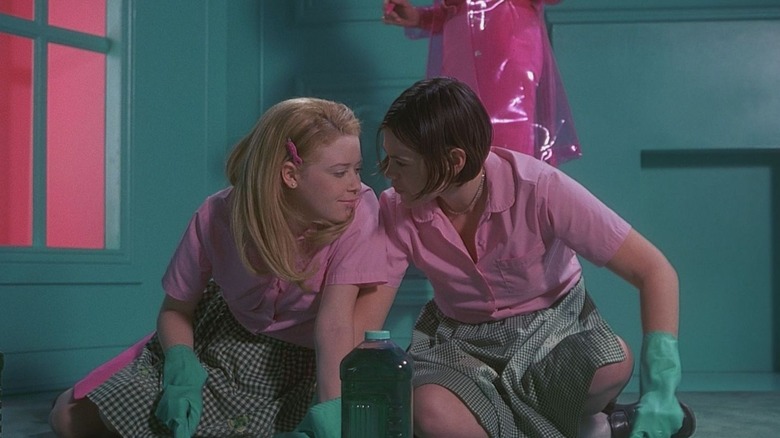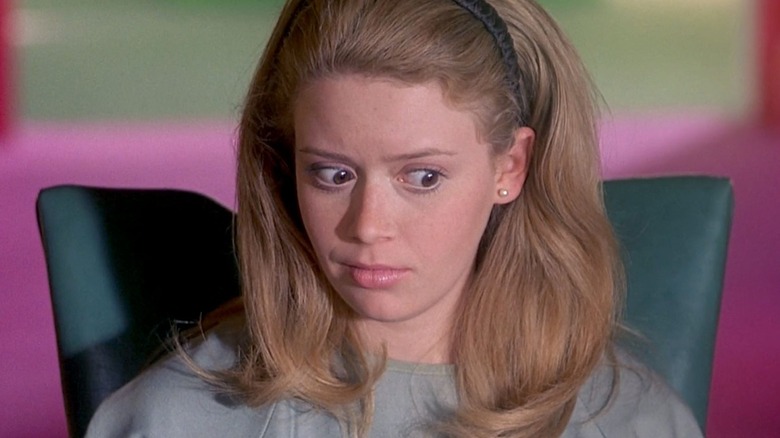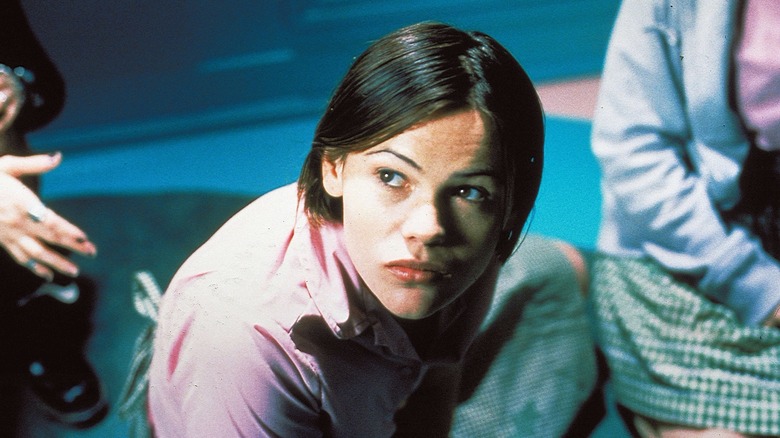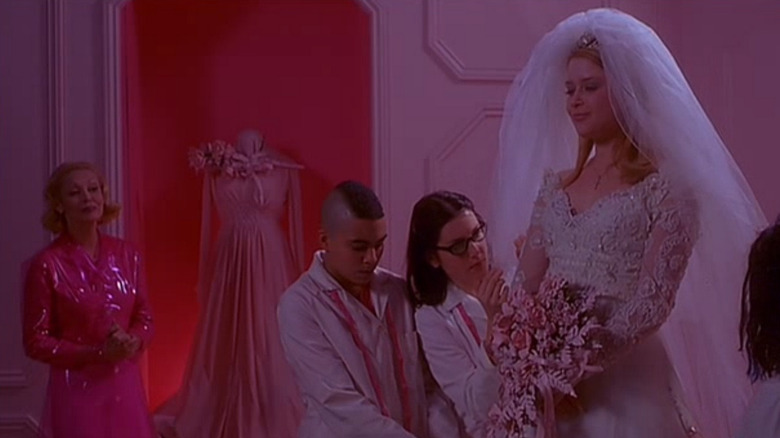But I'm A Cheerleader Ending Explained: Conversion Camps Are Absurd
We may receive a commission on purchases made from links.
Jamie Babbit's 1999 film "But I'm a Cheerleader" is a broad, colorful satire that takes aim at that most deserving of targets: conversion camps for teens. So-called conversion therapy, openly lambasted by the Human Rights Campaign, is the attempt to alter a young person's sexual orientation or gender identity, often using any number of abusive or manipulative means. As of this writing, conversion therapy is illegal in France, Germany, Spain, Mexico, Albania, Canada, and multiple U.S. States. Bans are pending in other countries. Many of these conversion camps are run by church groups, "ex-gay" ministries, and other non-profit organizations. Many people who have run said camps have come out to denounce them as psychologically torturous.
In media, conversion camps have appeared as the central setting of several recent major feature films. The 2022 slasher film "They/Them" is set at a conversion camp. The Netflix documentary "Pray Away" — a shortening of the conversion camp catchphrase "pray away the gay" — traces the extreme evangelical origins of Exodus International, a conversion movement that started in the 1970s and disbanded in 2013. The 2018 film "The Miseducation of Cameron Post" is about a teen girl who falls in love with a female classmate and is sent by her conservative grandparents to a camp, and Joel Edgerton's "Boy Erased" from that same year follows a teenage boy into a camp that is decidedly church-like.
Prior to all those films, though, came Babbit's "But I'm a Cheerleader," a lighthearted, optimistic, and hilarious skewering of conversion camps and traditional heteronormativity seen through a pink-tinged, cartoony, John Waters-inflected lesbian love story. The film wasn't terribly well-received upon its release — some didn't like Babbit's whimsical leniency — but some now consider it to be one of the better queer films of all time.
True Directions
Babbit appears keen on exposing a practical fallacy of gay conversion camps. If the point is to discourage queer teens from forming relationships with other queer teens, then why gather them together in one location where they can flirt and make out and fall in love? Babbit — eschewing the real-life abuse of such places — satirizes conversion camps by pointing out that they could easily function as a catalyst for queer romance. That's certainly how it worked out for Megan (Natasha Lyonne) the titular cheerleader. Megan hates making out with her lascivious hunky sports star boyfriend (he's also not a very good kisser), and seems to spend far more time looking at her fellow cheerleaders.
Her parents (Bud Cort and Mink Stole) see this as evidence enough that she is a lesbian, and sign her up for True Directions, an ex-gay conversion program that not only seeks to reprogram queer-leaning youths as heterosexual, but also teaches them to embrace bland post-WWII American suburban values and aesthetics. The camp is run by the "ex-gay" Mike (RuPaul) and the iron-fisted ultra-matron Mary Brown (Cathy Moriarity, who is always great).
At True Directions, Megan — assuming she is straight — meets other queer kids, notably Graham (Clea DuVall) an out-and-proud lesbian eager to defy the system. It's not until she is prodded by the counselors that Megan begins to realize that she is indeed attracted to women. As Megan and Graham are forced through their sexist 1950s housewife training, they clearly begin developing an attraction. It's not until they briefly flee the camp to hang out at a local gay bar — one populated by ex-ex-gays — that Megan sees the folly of such camps. She and Graham openly admit their attraction and become properly romantically entwined.
Censorship issues
Babbit and her then-girlfriend Andrea Sperling conceived of the idea for "But I'm a Cheerleader" as a sendup of the 12-step recovery programs that Babbit's mother ran. Her ideas were laid out in a Post Script interview, handily compiled in the book "Film Voices." Babbit saw cheerleaders as the pinnacle of archetypal American femininity, and wanted to use a cheerleader character to tell a lesbian love story from the perspective of a "femme" lesbian. Many of the lesbian films of the mid-1990s — films like "Go Fish" and "The Watermelon Woman" – were too often about "butch" lesbians.
In Kirby Dick's 2006 documentary film "This Film is Not Yet Rated," Babbit is interviewed about the struggle she had over her film's rating. Initially, "Cheerleader" was to be rated NC-17 for, it seems, relatively tame sexual references. The contested scenes were a shot of Graham touching Megan over her clothes, a scene where Megan is masturbating, also while fully clothes, and a spoken reference to Megan performing cunnilingus. Babbit was outraged at the rating, citing "American Pie" from that same year as featuring far more explicit scenes of teen sexuality — including a masturbation scene — yet still receiving an R rating. "But I'm a Cheerleader" had to be edited down to avoid an NC-17 rating, which, to Babbit, was irrefutable evidence that the MPAA ratings system is a homophobic institution. Notoriously, queer films get harder ratings than heterosexual films.
If one adopts the thinking patters of a conspiracy theorist, one can perhaps posit that "But I'm a Cheerleader," in being a film about tearing down ridiculous and dated homophobic institutions, attracted the ire of homophobic people. It almost seems like a queer film is being censored. If one were paranoid.
Everyone gets married in the end
Ancient theatrical traditions demand that lovers marry at the end of the story, and "But I'm a Cheerleader" follows suit. The climax of True Directions is that the boys and the girls select opposite-sex partners and engage in a mock wedding. The young women wear traditional gowns, the young men tuxedos. They are then set out into the world, heteronormatively paired, presumably ready to be straight-presenting in perpetuity. In true rom-com fashion, Graham's sham wedding is interrupted by Megan who performs a cheerleading routine, declaring her love for Graham. This was a doubly sweet moment, as it was the first time Graham was permitted to see Megan ply her favorite skill. The two run off together to kiss and laugh and be in love.
While Megan and Graham don't officially marry in "But I'm a Cheerleader," the wedding dress and setting present a symbolic version of the act. These two young women are, at least visually, marrying.
It's worth remembering that "But I'm a Cheerleader" was released in 1999, long before same-sex marriage was legal in the United States. It wouldn't be until 2004 that same-sex marriage would be made legal in Massachusetts, with California and Connecticut following suit in 2008. Over the course of the sext seven years, unions would finally be legalized in the rest of the country, with the landmark 2015 case Obergefell v. Hodges. The decision is, thanks to alarming statements by right-wing politicians, currently under threat.
Babbit appeared to be mocking marriage as an old, outmoded, discriminatory institution with True Directions. With Graham running off in a wedding dress, she is essentially stealing marriage back. "But I'm a Cheerleader" ends with a stirring political statement: Marriage is for everyone.



